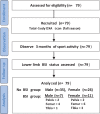Anthropometric Factors Associated With Bone Stress Injuries in Collegiate Distance Runners: New Risk Metrics and Screening Tools?
- PMID: 35178462
- PMCID: PMC8844446
- DOI: 10.1177/23259671211070308
Anthropometric Factors Associated With Bone Stress Injuries in Collegiate Distance Runners: New Risk Metrics and Screening Tools?
Abstract
Background: Lower limb bone stress injury (BSI) of the pelvis, femur, and tibia is prevalent in collegiate track and field distance runners. Bone mineral density (BMD), body composition (BComp), and anthropometric parameters before initial collegiate injury have not been compared between runners with BSI and their noninjured counterparts.
Purpose: To characterize bone health in relation to BComp and anthropometric measurements from total-body dual x-ray absorptiometry (DXA) scans in collegiate male and female distance runners before BSI and develop BMD prediction models.
Study design: Case-control study; Level of evidence, 3.
Methods: Distance runners (N = 79) from a single university track and field team were retrospectively enrolled into this study. The runners completed a DXA scan during the fall season (August-November) and participated in sport activities before the scan. Three months after scanning, electronic medical records were reviewed for the occurrence of BSI. An independent-sample t test was used to compare BMD (total and regional [spine, pelvis, and legs]), BComp (% body fat, fat mass, and lean mass), and anthropometric measurements (shoulder width and leg, arm, and trunk length) between runners with versus without BSI (included subgroup analysis by sex). Multiple linear regression with stepwise removal was used to determine variables most predictive of BMD.
Results: Of the 79 enrolled participants (42 male, 37 female), 18 runners (22.8%; 11 female, 7 male) sustained a lower limb BSI. Compared with the noninjured group, injured runners had lower total and regional BMD (P < .001 for all) and shorter leg and arm lengths (P < .05 for both), whereas injured male runners had lower fat mass and injured female runners had lower lean mass in the legs (P < .05 for both). Injured runners' age-matched total BMD Z score (-0.1 ± 0.6) was considered clinically normal. BComp and anthropometric measures were predictive of total and regional BMD (P < .05; R 2 = 0.64-0.80; percentage error = 3.8%-4.8%).
Conclusion: The DXA scans of injured runners prior to incidence indicated lower BMD compared with noninjured runners. Shorter limb lengths, lower fat mass (male), and lower leg lean mass (female) may also be indicative of risk. Certain BComp and anthropometric measures were predictive of BMD.
Keywords: DXA; bone; collegiate; distance; injury; runners.
© The Author(s) 2022.
Conflict of interest statement
One or more of the authors has declared the following potential conflict of interest or source of funding: P.C.M. has received education payments from Arthrex and Smith & Nephew, consulting fees from Smith & Nephew, and honoraria and nonconsulting fees from Vericel. AOSSM checks author disclosures against the Open Payments Database (OPD). AOSSM has not conducted an independent investigation on the OPD and disclaims any liability or responsibility relating thereto.
Figures



References
-
- Barrack MT, Fredericson M, Tenforde AS, Nattiv A. Evidence of a cumulative effect for risk factors predicting low bone mass among male adolescent athletes. Br J Sports Med. 2017;51(3):200–205. doi:10.1136/bjsports-2016-096698 - PubMed
-
- Barrack MT, Gibbs JC, De Souza MJ, et al. Higher incidence of bone stress injuries with increasing female athlete triad—related risk factors: a prospective multisite study of exercising girls and women. Am J Sports Med. 2014;42(4):949–958. doi:10.1177/0363546513520295 - PubMed
-
- Beermann BL, Lee DG, Almstedt HC, McCormack WP. Nutritional intake and energy availability of collegiate distance runners. J Am Coll Nutr. 2020;39(8):747–755. doi:10.1080/07315724.2020.1735570 - PubMed
-
- Bennell K, Crossley K, Jayarajan J, et al. Ground reaction forces and bone parameters in females with tibial stress fracture. Med Sci Sports Exerc. 2004;36(3):397–404. doi:10.1249/01.mss.0000117116.90297.e1 - PubMed
-
- Bennell KL, Malcolm SA, Thomas SA, et al. Risk factors for stress fractures in track and field athletes: a twelve-month prospective study. Am J Sports Med. 1996;24(6):810–818. doi:10.1177/036354659602400617 - PubMed
LinkOut - more resources
Full Text Sources

